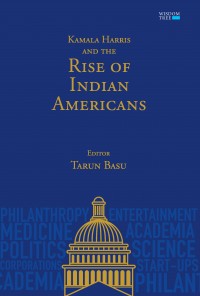“This is the first time the contributions of Indian Americans have been synthesized in one place. It makes me proud that people who are rooted in the world’s largest democracy are contributing to the world’s oldest and greatest democracy. It is unprecedented. Kudos to the authors.” – Indra Nooyi, Former Chair and CEO of PepsiCo
Here is an excerpt from M.R. Rangaswami’s chapter in Kamala Harris and the Rise of Indian Americans (Wisdom Tree, 2021) – an anthology of essays.
THE 1980’S: A MYTHICAL PLACE
Many young Indians now dream of coming to “The Valley”—a place I didn’t even know existed when I left Chennai for Ohio’s Kent State University.
I didn’t come to America with a grand plan. I was an Indian student in the 1970s who came to the US with a few dollars in his pocket and one modest goal: to get a master’s degree. I planned to return to India with a master’s in business administration (MBA) in hand, but I ended up getting a practical training visa and also a job offer.
I decided to take the position and stay in America. I moved to Houston to work as operations manager for a manufacturing company. Every day, although I was an executive, I donned a hard hat and steel-toed boots to help keep the factory running smoothly. After three years, I attended a certification program in software system best practices. My instructor enquired about my job during a break. When he gathered that I was good with software, he grabbed my arm, looked me in the eye, and said: “You have to go to Silicon Valley.”
It was the best piece of advice I ever got.
I had begun to hear tales of this mythical “Silicon Valley” place. I knew it was a growing center of the technology business, but I was at a bit of a loss as to how I could fit in. There was no internet, LinkedIn or Facebook. So I went to the local library, sat down at the microfiche machine, and began searching old copies of the San Jose Mercury News and the San Francisco Chronicle, to read up on the companies in the area.
My research ended with a list of potential employers. I typed up cover letters, Xeroxed my résumé, and sent off a dozen inquiries through snail mail. Incredibly, one executive flew me out to California and gave me a job on the spot!
START-UP LIFE
I had accidentally joined my first start-up. My new job was a world away from my experience at the manufacturer in Texas. Here, we wore khakis, had working lunches in the conference room, and often shared a beer after work. As the in-house expert on manufacturing, I felt empowered to have an impact on our trajectory. I helped fine-tune the product and marketing of our software to US clients. Our revenue doubled during my first year—and my second!
And then we went bankrupt.
It was my first start-up—my first success, and my first failure. Little did I know there would be plenty more wins and losses in the years to come.
And that’s the true story of Silicon Valley: 99 percent of start-ups fail. The media can’t possibly cover all of the failures, so it focuses on the successes.
But back in 1986, I was shocked by the failure—and I was hooked. I never once thought of returning to Texas, or India. Deloitte snatched me up as a consultant. My software and operations management skills were in high demand; I spent the next couple of years parked there—advising clients, watching the industry, and waiting for my next move.
Excerpted from Kamala Harris and the Rise of Indian Americans. Edited by Tarun Basu. Published by Wisdom Tree.

